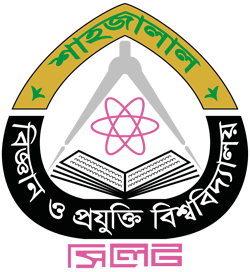- Home
- About Us
- Academics
-
Offices
- Office of the Vice Chancellor
- Office of the Pro Vice Chancellor
- Office of the Treasurer
- Office of the Registrar
- Office of The Dean, School of Agriculture and Mineral sciences
- Office of The Dean, School of Applied Sciences and Technology
- Office of The Dean, School of Life Sciences
- Office of The Dean, School of Management & Business Administration
- Office of the Dean, School of Physical Sciences
- Office of the Dean, School of Social Sciences
- Others
- Research
- Admission
- Campus Life
- Notice Board
- SUCSU
Responsive Mobile Menu
Shahjalal University of Science and Technology
-
Overview
-
Academic
- Program
- Admission
- Session-wise Curriculum
- Student Engagement & Support
-
Research
-
Faculty
-
Student Adviser
-
Former Head
-
Officers
-
Scholarship
-
Activities
-
Announcement
- Notice Board
- News & Events
-
Awards & Honours
- Graduate Student Awards
- Research Awards
- Teaching Awards
- Service Awards
-
Alumni
-
Collaboration
- Academic
- Research
- Student Chapter
-
Contact Us
Overview
| Full time | Part time | Headcount | FTE | ||
| Faculty Statistics | |||||
| 1.1 | Number of academic staff | 20 | 0 | 20 | 20 |
| 1.2 | Number of academic staff of international/overseas origin | 0 | 0 | ||
| 1.3 | Number of academic staff that are female | 6 | 0 | 6 | 6 |
| 1.4 | Number of faculty staff with PhD | 11 | 0 | 11 | 11 |
| Research Staff Statistics | |||||
| 2 | Number of research staff | 0 | 0 | ||
| Students Statistics | |||||
| 3.1 | Number of total students | 227 | 0 | 227 | 227 |
| 3.2 | Number of students that are female | 99 | 0 | 99 | 99 |
| 3.3 | Number of bachelors/undergraduate students | 173 | 0 | 173 | 173 |
| 3.4 | Number of undergraduate students of international/overseas origin | 0 | 0 | ||
| 3.5 | Number of masters students | 54 | 0 | 54 | 54 |
| 3.6 | Number of masters students of international/overseas origin | 0 | 0 | ||
| 3.7 | Number of doctorate students | 0 | 0 | ||
| 3.8 | Number of doctorate students of international/overseas origin | 0 | 0 | ||
| Student Performance Statistics | ||
| 4.1 | Student Continuation Rate (in %) | 90 |
| 4.2 | Student Retention Rate (in %) | 2 |
| 4.3 | Completion Rate (in %) | 98 |
| 4.4 | First Generation Learners | |
| Degrees Information | ||
| 5.1 | Number of total undergraduate degree programs offered | 1 |
| 5.2 | Number of total undergraduate degree programs offered online | 0 |
| 5.3 | Number of undergraduate degrees awarded | 39 |
| 5.4 | Number of total postgraduate degree programs offered | 2 |
| 5.5 | Number of total postgraduate degree programs offered online | 0 |
| 5.6 | Number of master’s degrees awarded (MSc, MBA, MA, MPhil) | 22 |
| 5.7 | Number of doctorates awarded | 0 |
| Tuition Fees | ||
| 6.1 | Average annual tuition fees for an undergraduate program (BDT) | 9000 |
| 6.2 | Average annual tuition fees for an international undergraduate program (BDT) | 17500 |
| 6.3 | Average annual tuition fees for postgraduate programs – Master’s (BDT) | 6000 |
| 6.4 | Average annual tuition fees for postgraduate programs – PhD (BDT) | 20000 |
| 6.5 | Average annual tuition fees for international postgraduate programs (Master’s & PhD) – SAARC countries (USD) | 500 |
| 6.6 | Average annual tuition fees for international postgraduate programs (Master’s & PhD) – non-SAARC countries (USD) | 1200 |
| Exchange Student Statistics | ||
| 7.1 | Number of undergraduate exchange students – Inbound | 0 |
| 7.2 | Number of undergraduate exchange students – Outbound | 0 |
| 7.3 | Number of graduate/postgraduate exchange students - Inbound | 0 |
| 7.4 | Number of graduate/postgraduate exchange students - Outbound | 0 |
| Institutional Income | ||
| 8.1 | Research income | 4200000 |
| 8.2 | Research income from industry and commerce | 0 |
| Total (7.1 + 7.2) | 4200000 | |
The Department of Biochemistry and Molecular Biology (BMB) has started its journey as an essential area of knowledge in understanding the chemical & molecular basis of life. At the beginning, Biochemistry was regarded as a research-oriented subject to find out the cause of different types of diseases both of plant and animal including human and to propose the biochemical solution of that diseases. Gradually it turns into an applied science and it proved its application in food and agriculture, disease diagnosis, fermentation industries and in pharmaceutical research. But with the rapid development of Molecular Biology research from the seventies of last century, the Biochemists and Molecular Biologists have been able not only to understand the life process but to change it according to need. In fact, the knowledge of Biochemistry, Molecular Biology and Biotechnology proved its tremendous impact on the health, agriculture, food, forensic science and pharmaceuticals which contribute to the economic development of the country. But in Bangladesh, BMB departments were in few public universities namely Dhaka, Rajshahi, Jahangirnagar, Mymensingh Agriculture University, and Chittagong University till 2010. Understanding the immense importance of this subject and its growing demand both at home and abroad it seemed practically necessary to generate more graduate in the country. As a result, the department of BMB was opened in SUST in 2010 and by the next year (in 2011) started its academic activities with 4 teachers and 20 students.
VISION: The department of Biochemistry and Molecular Biology offers high quality learning and research oriented atmosphere in life sciences to attain proficiency in identifying the challenges throughout the century between biological and human resources and renovate it to augment the quality of life.
MISSION:
To provide broad knowledge in concept and principles of biochemistry and molecular biology.
To encourage and assure high quality research and other scholarly activity on the part of both faculty and students.
To identify local and global issues and design intelligent strategies and biochemical approaches in problem solving methods.
To cultivate interdisciplinary collaborative research to generate and to disseminate new knowledge in the area of molecular biology, immunology, neuroscience, clinical biology and bioinformatics.
To build a group of efficient graduates in the field of biochemistry and molecular biology to meet the new era’s worldwide demands.


